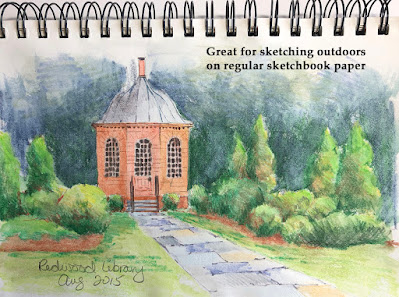I gave a talk and demo at Rhode Island Watercolor Society on July 12 and told my viewers I would put all the notes on my blog. So here they are:
Watercolor pencil is useful for control, adding detail and sketching. It is a portable medium for working outdoors or traveling all you need are watercolor pencils, a brush and a small amount of water.
There are many brands of watercolor pencils on the market, the ones I like to use are:
1. Faber Castell Albrecht Durer - these pencils are sold individually or in sets up to 120 pencils. Most are lightfast and are made up of acid free pigments. These pencils apply smoothly and can be used wet or dry. I splurged for the 120 pencil set as it has a great range of colors and values from very light to dark. These are my favorite watercolor pencils. (I haven't put together a color chart for these yet)
2. Caran d'Ache Supracolor - these pencils come in sets up to 120 pencils. Not all colors are lightfast but they have a good range of color, value. They also apply smoothly with or without water applied.
3. Derwent Inktense - sold in sets up to 100 pencils. Inktense are vibrant with intense color because they are ink based and permanent, so you cannot lift color once it is dry. You can also use these pencils on ceramic wood and fabric. I am anxious to experiment with the Inktense pencils on fabric as colors will be permanent once dried.
4. Derwent Graphitint - these pencils are sold in sets of 12 or 24. They consist of water soluble graphic and colored pigment. Graphitint pencils create softer hues and are not permanent so the pigment can be removed with water or an eraser. (I have a set of 12 pencils)
Other pencils I like are the Stabilo White Aquarabelle ALL, this water soluble pencil works on a variety of surfaces and has great coverage for adding white details and highlights on top of color. These Stabilo pencils also come in other colors.
I often use a regular wax based colored pencil for adding details and fine lines as the wax pencil is not water soluble so it won't lift when water is applied around it.
Paper:
I always use good quality paper, 140 lbs paper weight is sufficient if you aren't putting a lot of large wet washes on the paper. Hot press finish works the best because of its smoother texture. Cold press or rough contain textured grooves in the paper that are hard to fill with the pencil point. My go-to choices are Winsor Newton or Arches but I have recently tried Legion Stonehenge Aqua and like working on it. I also like to use watercolor blocks which are portable and easy to work on because the paper is affixed to the block and doesn't need to be taped to a board. Otherwise I will purchase individual sheets, cut them to the size I need and tape to a board.
Application:
I purchase an inexpensive watercolor pad for testing my colors. I like to make color charts of each brand of watercolor pencils, showing how each color looks when it is applied dry and then water is added. Some pencil pigment colors do change significantly when water is added.
Above is my application testing sheet You don't mix colors on a palette as you do in traditonal watercolor, watercolor pencils are layered (light to dark) to create the color and value you want to achieve. I used inexpensive cold press paper for testing and realize later that I should do my testing on good paper for more accurate results. However you can see that cold press paper is not good for watercolor pencils because you can really see the texture even when blended.
I apply the colors dry first, then add water. You only want a small amount of water on your brush so activate the pencil and keep your brush clean when moving from one color to another.
Allow your layers of color to dry before adding another color to prevent your colors from mixing and becoming muddy.








No comments:
Post a Comment